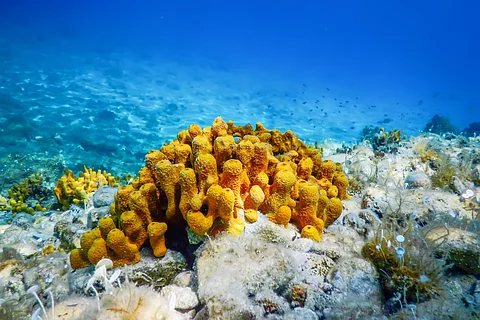

ISTOCK
When you hear the word “sponge,” you might picture the bright yellow thing in your kitchen sink or maybe even a certain cartoon character who lives in a pineapple under the sea. But real sea sponges are far stranger—and more fascinating—than anything you’ll find in a cleaning aisle or on television. They might look like plants or even colourful rocks, but sea sponges are actually animals, and they’ve been quietly living on Earth for hundreds of millions of years. In fact, sea sponges are so old that they were among the first animals ever to exist—long before dinosaurs stomped around or even before trees covered the land!
So, what exactly is a sea sponge? Imagine picking up a weird, squishy bath sponge and finding out it’s alive. That’s what a sea sponge is like in the ocean, although they come in a wild variety of shapes, sizes, and colours. Some look like fancy vases, others like tubes or delicate fans, and some just look like blobs of jelly. Unlike most animals, sponges have no brains, no hearts, no eyes, and not even a mouth. Instead, their bodies are like a complicated network of tunnels and chambers, full of tiny holes called pores. These pores are the secret to how sponges survive.
Here’s how it works: seawater flows into the sponge through thousands of microscopic pores, carrying with it bits of food like bacteria and plankton. Special cells inside the sponge, called choanocytes, have tiny hairs that whip back and forth, creating a current that pulls water in and pushes it out. As the water moves through, the sponge filters out the good stuff and eats it. You could say that sponges are nature’s vacuum cleaners—only much cooler. Some large sponges can filter hundreds of litres of water every single day!
But that’s not even the weirdest thing about them. While sponges might not be able to run away from predators, they’ve got some tricks up their sleeves (if they had sleeves). Some sponges produce toxic chemicals that taste terrible or can even poison fish and other creatures that try to munch on them. Scientists are so impressed by these chemicals that they’re studying sea sponges to see if their special powers could help humans fight diseases like cancer or create new medicines.
Sponges are also masters of disguise and survival. If a sponge gets broken into pieces by waves or hungry turtles, those pieces can often grow into brand new sponges. In fact, if you chop up a sponge into tiny bits, the cells can reassemble themselves like a living jigsaw puzzle and make a whole new sponge! Imagine if you could do that after falling off your bike—just pick up the pieces and put yourself back together.
You might think sponges live only in warm, tropical seas, but they’re everywhere. Some sponges cling to rocks along the coast, while others grow in the deepest, darkest parts of the ocean, where sunlight never reaches. The Venus’ flower basket, a type of glass sponge, grows deep in the Pacific Ocean and looks like a sparkling, woven basket made from glass threads. Fishermen used to use natural sponges for bathing, painting, and even in helmets, but most of the sponges you see in shops today are actually made from plastic or other materials, not from real sea sponges.
Sea sponges also help keep the ocean healthy. By filtering water, they clean it, remove waste, and provide homes for all sorts of creatures—tiny shrimps, colourful fish, and sometimes even sea turtles. In fact, some animals live their whole lives inside sponges, hiding from predators or sneaking bites of food. In coral reefs, sponges play a vital role in recycling nutrients and supporting the food chain, like a quiet but important player in a bustling underwater city.
If you’ve ever seen a coral reef bursting with colour, chances are there are sponges hiding there too. Some are bright blue, red, or yellow, while others are camouflaged so well that only a sharp-eyed diver will spot them. Sponges come in all shapes, from enormous barrels big enough to sit in, to thin, crusty patches that blend right into the rocks.
One of the coolest things about sea sponges is how tough they are. They’ve survived mass extinctions, ice ages, and all sorts of challenges. Even when the world above water changes, the sponges keep going, quietly cleaning the sea and supporting countless other creatures. Some deep-sea sponges can live for thousands of years, making them some of the oldest living things on the planet.
Scientists are still discovering new kinds of sponges, and learning more about how they live. There’s even hope that sponges will help us solve big problems, like finding new medicines, cleaning up polluted water, or teaching us more about how life began on Earth.
Although they look like underwater flowers or rocks, sea sponges are living animals—one of the simplest and oldest animal groups on Earth.
Some deep-sea sponges are thought to be more than 11,000 years old, making them among the longest-living animals on the planet.
Sponges don’t have brains, hearts, or even nerves. They survive by pumping water through their bodies and absorbing nutrients.
A single large sponge can filter hundreds of litres of water every day, removing bacteria and tiny particles—helping to keep the ocean clean and healthy.
Glass sponges have skeletons made from silica, the same substance as glass. The Venus’ flower basket is a famous example that looks like a delicate glass basket.
Their filtering technique has inspired scientists to design better water filters and even ideas for cleaning up pollution.
Tiny shrimps, fish, worms, and crabs sometimes make their homes inside sponges, using them for shelter and safety from predators.